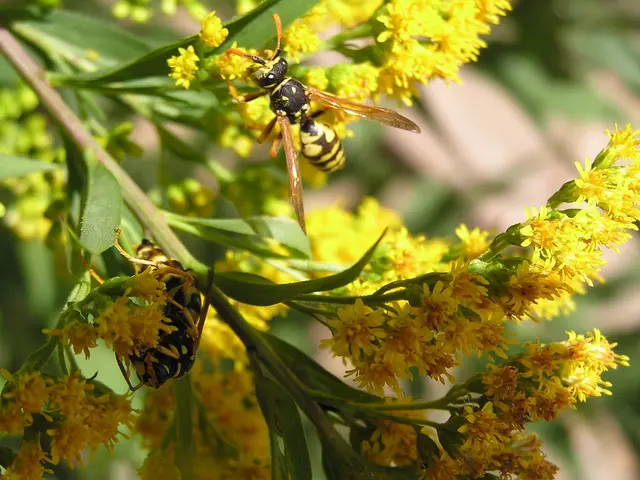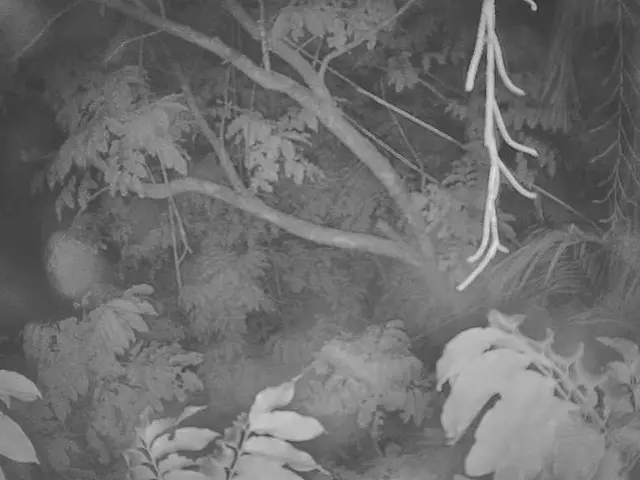Readying Your Garden for a Cicada Invasion
In Your Backyard, Every Decade or Two, It's Showtime for Striking Cicadas!
Get ready for a mesmerizing display of nature straight out of your backyard! These incredible insects, known as periodical cicadas, are native to North America and emerge every 13 or 17 years. They're dubbed "periodical cicadas" because most of the population pops up simultaneously, with none during the in-between years – though a few stragglers might appear slightly early or late. Each group of cicadas belonging to the same emerging cohort is called a brood and is designated by a Roman numeral.
With their black bodies, vivid orange wing veins, and ruby-red eyes, periodical cicadas are quite a sight to behold. "You're witnessing an extraordinary biological event that isn't repeated anywhere else in the world," says Eric Day, an extension entomologist from Virginia Tech, who's also in charge of the Insect Identification Clinic. "While we do have other types of cicadas appearing annually, the mass emergences of periodical cicadas are a unique trait found only in eastern North America."
For 17 years, these insects live underground without eating a thing before they emerge and start looking for love. After mating, females lay their eggs in branches, according to Day. The eggs hatch in six to ten weeks, and the newly minted nymphs tumble back to the earth, burrow underground, and wait for their next emergence, which will occur in another 13 or 17 years.
Before you start worrying, rest assured that these insects are not poisonous, nor do they sting. However, it's best not to let your pet nibble on them due to the risk of choking on their crunchy exoskeleton.
The scarce appearance of periodical cicadas gifts us front-row seats to one of the world's most awe-inspiring natural wonders. But if you're fretting about these inch-long insects wreaking havoc on your garden, worry no more! Read on for Day's tips on safeguarding vulnerable plants:
When Can I Expect Periodical Cicadas?
Depending on your location, you might see a horde of them or none at all. They start appearing once the soil temperature at a depth of 7 to 8 inches reaches approximately 64°F, which can occur anytime between April and June. Adult cicadas usually live for around four weeks.
In 2025, make sure to keep an eye out for Brood XIV of the 17-year cicadas. You'll most likely spot them in West Virginiana, Kentucky, and TN; Southwest Virginia, western North Carolina; and North Georgia. To visualize where, check out the map here.
Will Periodical Cicadas Eat My Garden Plants?
Good news for garden enthusiasts – these insects pay no heed to your garden plants, including annuals, perennials, and edibles. While they might be spotted lounging on these plants, it's likely that they've just emerged from the ground and are waiting for their tough shell to harden before searching for a partner, then bounding up into the trees to lay eggs.
However, young saplings or fruit trees may experience damage. "Cicadas can cause considerable damage to these plants as the female lays her eggs in slits of the bark on branches," says Day. "This can result in disfigurement of the tree and structural issues later. It might take a few years for the tree to recover."
The damage will occur within a week or so, as branch tips begin to wilt – a phenomenon commonly known as "flagging." While older, fully mature trees can weather it, younger saplings may not survive the brutal onslaught.
How Do I Save My Young Trees from Cicadas?
If you have a newly-transplanted tree, a sapling that's three years old or younger, or a small fruit tree, consider offering it some protection. Here's how:
- Plan to cover the tree for the entire emergence period, which will last approximately late April to June, depending on where you reside.
- Use fine tree or garden netting with holes no larger than 1/4-inch. Cicadas are too big to wriggle through smaller openings.
- Drape the tree's canopy with netting and secure it in place below the lowest branches. No need to wrap the trunk.
- Do not consider using pesticides – they're unnecessary and potentially hazardous.
- If possible, push back planting young trees until the fall. By then, the cicada festivities will be over until the next mass emergence occurs.
How Do Periodical Cicadas Produce Their Distinctive Song?
Cicada wings are more than just a pretty facade – they are also a complex musical instrument. Male cicadas create their famous song by rapidly contracting tymbal membranes within their abdomens. This creates distinct vibrations that travel through their wings and cause them to buzz and hum a symphony of sound.*
Female cicadas tune in to these melodies with the help of specialized sensory organs called tymbalum receptors. These receptors, located in their abdomens near their genitals, sense the intensity of the vibrations coming from the males. By measuring these vibrations, the females determine whether the signal is loud enough to come from a worthy suitor and ready to mate.
References
- 1: Entomology at Purdue University. (2020). Periodical Cicada Brood XIV (Magicicada cassini). Purdue University Extension.
- 2: Pompowy, J. (2012). Periodical Cicada Life History and They don't Appear Every 13 or 17 years. University of Illinois Extension IPM Department.
- 3: University of Louisville. (n.d.). Cicadas. Department of Pharmaceutical Sciences Education.
- 4: Selfridge, J. (2021). Why do cicadas emerge in such large numbers? Inaturalist.
- Southern Living magazine offers gardening ideas to safeguard vulnerable plants during the emergence of periodical cicadas, a natural phenomenon that occurs every 13 or 17 years.
- Periodical cicadas are not a threat to home-and-garden lifestyles, but they may cause damage to young saplings or fruit trees when females lay eggs in bark slits, leading to structural issues.
- In 2025, Brood XIV of the 17-year cicadas is expected to emerge in West Virginia, Kentucky, TN, Southwest Virginia, western North Carolina, and North Georgia. Garden enthusiasts are advised to check a map for exact locations.
- To protect young trees from cicada damage, gardeners are recommended to use fine netting to cover the tree canopy for the emergence period, late April to June, avoiding the use of pesticides.
- The distinctive song of periodical cicadas is produced by the rapid contraction of tymbal membranes within their abdomens, creating vibrations that travel through their wings, buzzing and humming a symphony of sound.
- Female cicadas use specialized sensory organs called tymbalum receptors to determine whether the vibrations coming from males are loud enough for mating, with the help of these organs located in their abdomens near their genitals.








